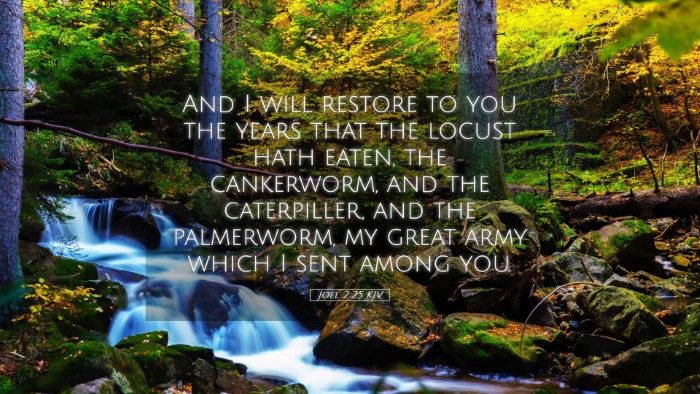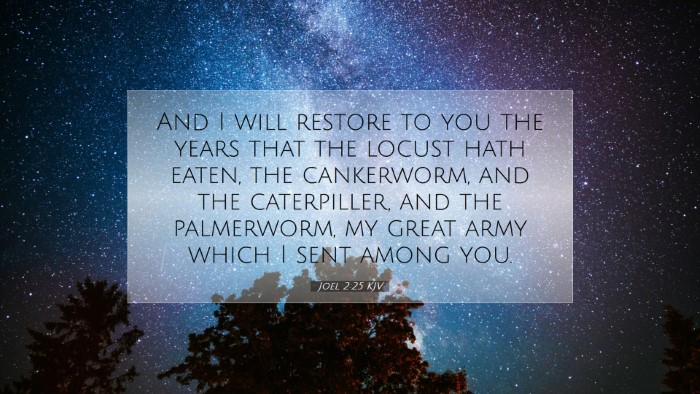Commentary on Joel 2:25
“And I will restore to you the years that the locust hath eaten, the cankerworm, and the caterpiller, and the palmerworm, my great army which I sent among you.”
Introduction
The verse Joel 2:25 holds a profound promise of restoration from God. It encapsulates a divine assurance that despite the devastation caused by various pests, symbolizing destruction and loss, God’s people will experience rejuvenation. This commentary integrates insights from several esteemed public domain commentaries, providing depth and clarity for pastors, students, theologians, and Bible scholars.
Divine Restoration
Matthew Henry emphasizes that the restoration promised by God is comprehensive and transformational. The locusts and other insects, representing calamities, stripped away the blessings of the land and the people. However, God's intervention is not merely to return what was lost; it is an act of divine grace to fulfill His covenant with His people.
Henry reflects that the restoration touches upon both spiritual and material aspects, indicating God’s capability to heal and uplift His people from despair. It reassures believers of a future that is not only a return to the past but a step into a renewed and more glorious state of being.
Contextual Analysis
Albert Barnes provides a contextual framework for understanding this verse within the broader narrative of Joel. The book highlights the themes of judgment and restoration, moving from a time of lament due to locust invasions—a symbol of God’s judgment—to a future hope marked by restoration. Barnes notes that the context is crucial; the initial calamity serves as a wake-up call for the people to repent and return to God.
This repentance is integral to receiving the promise. God’s intent is for His people to recognize their vulnerability and dependence on Him, which paves the way for His gracious restoration.
The Imagery of Devastation
Adam Clarke elaborates on the imagery invoked in Joel 2:25. The various insects mentioned—locusts, cankerworms, caterpillars, and palmerworms—represent a sequential devastation that signifies thorough destruction. Clarke notes that each insect serves as a metaphor for different forms of hardship and loss encountered by the community.
However, Clarke also highlights that noting these distinctions helps to appreciate the specific areas in which God will provide restoration. The detailed nature of the destruction underscores the profound nature of the divine promise to restore not just one aspect, but all that has been affected.
Implications for Believers
The promise of restoration in Joel 2:25 carries significant implications for believers today. Matthew Henry reflects on the mindset that believers should cultivate—a sense of expectation in God’s faithfulness. There is an invitation to hold onto hope, grounded in the character of God as a restorer.
Barnes discusses the importance of community and personal repentance as a necessary condition for experiencing God’s restoration. The text emphasizes that the blessings of God are not automatic; they come through a relational engagement with the divine.
Moreover, Clarke reminds us that experiencing restoration often requires active participation on the part of the believer—the recognition of loss, a longing for what was, and the faithful anticipation of what is to come. This process can be a profound journey of faith that enhances spiritual growth and resilience.
Theological Reflections
Theologically, Joel 2:25 invites us to reflect deeply on the nature of God’s promise. Henry highlights the attributes of God involved in this restoration—His mercy, compassion, and sovereignty. God, who sent the calamity as a corrective measure, is also the God who commits to redeeming and restoring His people.
Furthermore, this promise points to a larger narrative of redemption present in the biblical text, where loss and restoration are recurrent themes throughout the Scriptures, culminating in the ultimate restoration found in Christ. This connection can lead to enriching discussions on eschatology and the hope of renewal found in the Gospel.
Conclusion
In summary, Joel 2:25 serves as a beacon of hope for believers navigating periods of loss and desperation. The insights drawn from the commentaries of Matthew Henry, Albert Barnes, and Adam Clarke collectively affirm that restoration is a testament of God's unwavering faithfulness and grace. By understanding the depth of this promise, pastors, students, theologians, and Bible scholars can cultivate a rich theological discourse on the nature of divine restoration in both individual and communal contexts.


